 W
WA color space is a specific organization of colors. In combination with color profiling supported by various physical devices, and supports reproducible representations of color -- whether such representation entails an analog or a digital representation. A color space may be arbitrary, i.e. with physically realized colors assigned to a set of physical color swatches with corresponding assigned color names in -- for example -- the Pantone collection), or structured with mathematical rigor.
 W
WAdditive color, or "additive mixing", is a property of a color model that predicts the appearance of colors made by coincident component lights, i.e. the perceived color can be predicted by summing the numeric representations of the component colors. Modern formulations of Grassmann's laws describe the additivity in the color perception of light mixtures in terms of algebraic equations. Additive color predicts perception and not any sort of change in the photons of light themselves. These predictions are only applicable in the limited scope of color matching experiments where viewers match small patches of uniform color isolated against a grey or black background.
 W
WThe Adobe RGB (1998) color space is a color space developed by Adobe Systems, Inc. in 1998. It was designed to encompass most of the colors achievable on CMYK color printers, but by using RGB primary colors on a device such as a computer display. The Adobe RGB (1998) color space encompasses roughly 50% of the visible colors specified by the CIELAB color space – improving upon the gamut of the sRGB color space, primarily in cyan-green hues.
 W
WAn RGB color space is any additive color space based on the RGB color model. A particular color space that employs RGB primaries for part of its specification is defined by the three chromaticities of the red, green, and blue additive primaries, and can produce any chromaticity that is the 2D triangle defined by those primary colors. The primary colors are specified in terms of their CIE 1931 color space chromaticity coordinates (x,y), linking them to human-visible color.
 W
WCcMmYK, sometimes referred to as CMYKLcLm or CMYKcm, is a six-color printing process used in some inkjet printers optimized for photo printing. It complements the more common four color CMYK process, which stands for Cyan, Magenta, Yellow and Key (black), by adding light cyan and light magenta. Individually, light cyan is often abbreviated to Lc or c, and light magenta is represented as Lm or m.
 W
WThe CIE 1960 color space is another name for the (u, v) chromaticity space devised by David MacAdam.
 W
WThe CIELAB color space also referred to as L*a*b* is a color space defined by the International Commission on Illumination in 1976. It expresses color as three values: L* for perceptual lightness, and a* and b* for the four unique colors of human vision: red, green, blue, and yellow. CIELAB was intended as a perceptually uniform space, where a given numerical change corresponds to similar perceived change in color. While the LAB space is not truly perceptually uniform, it nevertheless is useful in industry for detecting small differences in color.
 W
WThe CMY color model is a subtractive color model in which cyan, magenta and yellow pigments or dyes are added together in various ways to reproduce a broad array of colors. The name of the model comes from the initials of the three subtractive primary colors: cyan, magenta, and yellow.
 W
WThe CMYK color model is a subtractive color model, based on the CMY color model, used in color printing, and is also used to describe the printing process itself. CMYK refers to the four ink plates used in some color printing: cyan, magenta, yellow, and key (black).
 W
WA color chart or color reference card is a flat, physical object that has many different color samples present. They can be available as a single-page chart, or in the form of swatchbooks or color-matching fans.
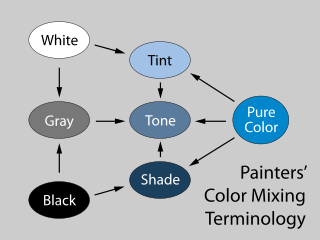 W
WA color solid is the three-dimensional representation of a color model, an analog of the two-dimensional color wheel. The added spatial dimension allows a color solid to depict an added dimension of color variation. Whereas a two-dimensional color wheel typically depicts the variables of hue and lightness, a color solid adds the variable of colorfulness, allowing the solid to depict all conceivable colors in an organized three-dimensional structure.
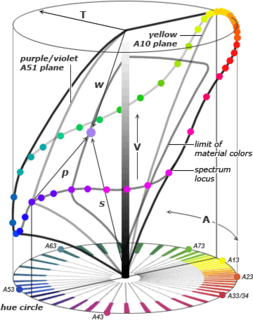 W
WThe Coloroid Color System is a color space developed between 1962 and 1980 by Prof. Antal Nemcsics at the Budapest University of Technology and Economics for use by "architects and visual constructors". Since August 2000, the Coloroid has been registered as Hungarian Standard MSZ 7300.
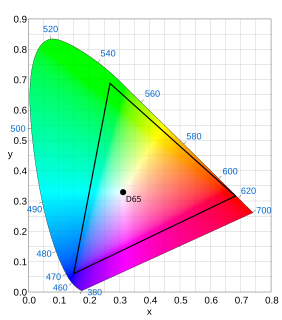 W
WDCI-P3, or DCI/P3, is a common RGB color space for digital movie projection from the American film industry.
 W
WThe Ekta Space is a common name for two color spaces developed by Joseph Holmes - Ekta Space PS 5 and Ektachrome Space to safely contain fine image scans of film originals generally of 24-bit color depth.
 W
WFarrow & Ball are a British manufacturer of paints and wallpapers largely based upon historic colour palettes and archives. Their colour names, such as Elephant's Breath, have become talking points in themselves.
 W
WIn color reproduction, including computer graphics and photography, the gamut, or color gamut, is a certain complete subset of colors. The most common usage refers to the subset of colors which can be accurately represented in a given circumstance, such as within a given color space or by a certain output device.
 W
WHCL (Hue-Chroma-Luminance) or Lch refers to any of the many cylindrical color space models that are designed to accord with human perception of color with the three parameters. Lch has been adopted by information visualization practitioners to present data without the bias implicit in using varying saturation. They are, in general, designed to have characteristics of both cylindrical translations of the RGB color space, such as HSL and HSV, and the L*a*b* color space.. Some conflicting definitions of the terms are:A name for a cylindrical transformation of CIELuv employed by Ihaka (2003) and adopted by Zeileis et al. (2009). This name appears to be the one most commonly used in information visualization. Ihaka, Zeileis, and co-authors also provide software implementations and web pages to promote its use. A name for cylindrical CIELab, employed by chroma.js. "HCL" designed in 2005 by Sarifuddin and Missaou, which is a transformation of whatever type of RGB color space is in use.
 W
WThe HKS is a colour system which contains 120 spot colours and 3520 tones for coated and uncoated paper. HKS is an abbreviation of three German colour manufacturers: Hostmann-Steinberg Druckfarben, Kast + Ehinger Druckfarben, and H. Schmincke & Co. The association of those three companies have defined the colours of the HKS system since 1968.
 W
WICTCP, ICtCp, or ITP is a color representation format specified in the Rec. ITU-R BT.2100 standard that is used as a part of the color image pipeline in video and digital photography systems for high dynamic range (HDR) and wide color gamut (WCG) imagery. It was developed by Dolby Laboratories from the IPT color space by Ebner and Fairchild. The format is derived from an associated RGB color space by a coordinate transformation that includes two matrix transformations and an intermediate nonlinear transfer function that is informally known as gamma pre-correction. The transformation produces three signals called I, CT, and CP. The ICTCP transformation can be used with RGB signals derived from either the perceptual quantizer (PQ) or hybrid log-gamma (HLG) nonlinearity functions, but is most commonly associated with the PQ function.
 W
WLMS, is a color space which represents the response of the three types of cones of the human eye, named for their responsivity (sensitivity) peaks at long, medium, and short wavelengths.
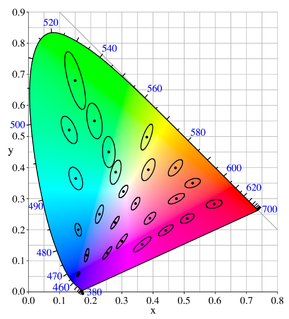 W
WIn the study of color vision, a MacAdam ellipse is a region on a chromaticity diagram which contains all colors which are indistinguishable, to the average human eye, from the color at the center of the ellipse. The contour of the ellipse therefore represents the just-noticeable differences of chromaticity. Standard Deviation Color Matching in LED lighting uses deviations relative to MacAdam ellipses to describe color precision of a light source.
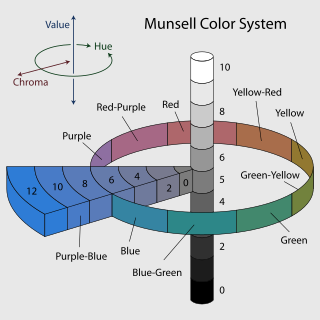 W
WIn colorimetry, the Munsell color system is a color space that specifies colors based on three properties of color: hue, chroma, and value (lightness). It was created by Professor Albert H. Munsell in the first decade of the 20th century and adopted by the United States Department of Agriculture (USDA) as the official color system for soil research in the 1930s.
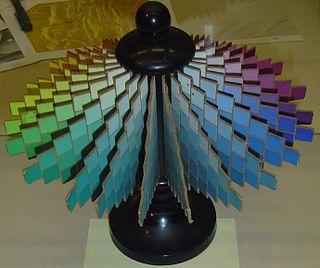 W
WIn colorimetry, the Ostwald color system is a color space that was invented by Wilhelm Ostwald. Associated with The Color Harmony Manual, it comprises a set of paint chips representing the Ostwald color space. There are four different editions of the Color Harmony Manual. Each manual is made up of charts, with each chart being a different color space.
 W
WIn physics and color science, the Planckian locus or black body locus is the path or locus that the color of an incandescent black body would take in a particular chromaticity space as the blackbody temperature changes. It goes from deep red at low temperatures through orange, yellowish white, white, and finally bluish white at very high temperatures.
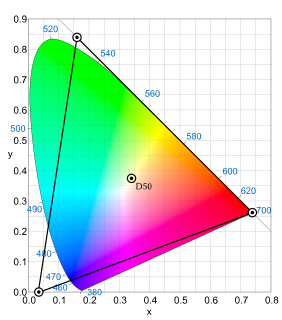 W
WThe ProPhoto RGB color space, also known as ROMM RGB, is an output referred RGB color space developed by Kodak. It offers an especially large gamut designed for use with photographic output in mind. The ProPhoto RGB color space encompasses over 90% of possible surface colors in the CIE L*a*b* color space, and 100% of likely occurring real-world surface colors documented by Pointer in 1980, making ProPhoto even larger than the Wide-gamut RGB color space. The ProPhoto RGB primaries were also chosen in order to minimize hue rotations associated with non-linear tone scale operations. One of the downsides to this color space is that approximately 13% of the representable colors are imaginary colors that do not exist and are not visible colors.
 W
WQuattron is the brand name of an LCD color display technology produced by Sharp Electronics. In addition to the standard RGB color subpixels, the technology utilizes a yellow fourth color subpixel (RGBY) which Sharp claims increases the range of displayable colors, and which may mimic more closely the way the brain processes color information. The screen is a form of multi-primary color display, other forms of which have been developed in parallel to Sharp's version.
 W
WRAL is a colour matching system used in Europe that is created and administrated by the German RAL gGmbH, which is a subsidiary of the German RAL Institute. In colloquial speech RAL refers to the RAL Classic system, mainly used for varnish and powder coating but now there are reference panels for plastics as well. Approved RAL products are provided with a hologram as of early 2013 to make unauthorised versions difficult to produce. Imitations may show different hue and colour when observed under various light sources.
 W
WRecommendation ITU-R BT.709-6 is the canonical reference from the ITU-R which standardizes the image encoding and signal characteristics of high-definition television. It is also known by the abbreviations Rec.709, BT.709, and ITU 709.
 W
WITU-R Recommendation BT.2020, more commonly known by the abbreviations Rec. 2020 or BT.2020, defines various aspects of ultra-high-definition television (UHDTV) with standard dynamic range (SDR) and wide color gamut (WCG), including picture resolutions, frame rates with progressive scan, bit depths, color primaries, RGB and luma-chroma color representations, chroma subsamplings, and an opto-electronic transfer function. The first version of Rec. 2020 was posted on the International Telecommunication Union (ITU) website on August 23, 2012, and two further editions have been published since then. It is expanded in several ways by Rec. 2100.
 W
WThe RG or red-green color space is a color space that uses only two colors, red and green. It is an additive format, similar to the RGB color model but without a blue channel. Thus, blue is said to be out of gamut. This format is not in use today, and was only used on two-color Technicolor and other early color processes for films; by comparison with a full spectrum, its poor color reproduction made it undesirable. The system cannot create white naturally, and many colors are distorted.
 W
WThe RGB color model is an additive color model in which red, green, and blue light are added together in various ways to reproduce a broad array of colors. The name of the model comes from the initials of the three additive primary colors, red, green, and blue.
 W
WAn RGB color space is any additive color space based on the RGB color model. A particular color space that employs RGB primaries for part of its specification is defined by the three chromaticities of the red, green, and blue additive primaries, and can produce any chromaticity that is the 2D triangle defined by those primary colors. The primary colors are specified in terms of their CIE 1931 color space chromaticity coordinates (x,y), linking them to human-visible color.
 W
WRGBA stands for red green blue alpha. While it is sometimes described as a color space, it is actually a three-channel RGB color model supplemented with a fourth alpha channel. Alpha indicates how opaque each pixel is and allows an image to be combined over others using alpha compositing, with transparent areas and anti-aliasing of the edges of opaque regions.
 W
WRYB denotes the use of red, yellow, and blue pigments as primary colors in art and applied design. Under traditional color theory, this set of primary colors was advocated by Moses Harris, Michel Eugène Chevreul, Johannes Itten and Josef Albers, and applied by countless artists and designers. The RYB color model underpinned the color curriculum of the Bauhaus, Ulm School of Design and numerous art and design schools that were influenced by the Bauhaus, including the IIT Institute of Design, Black Mountain College, Design Department Yale University, the Shillito Design School, Sydney, and Parsons School of Design, New York.
 W
WscRGB is a wide color gamut RGB color space created by Microsoft and HP that uses the same color primaries and white/black points as the sRGB color space but allows coordinates below zero and greater than one. The full range is -0.5 through just less than +7.5.
 W
WSpecifications for Web Offset Publications, invariably abbreviated to SWOP, is an organization and the name of a set of specifications that it produces, with the aim of improving the consistency and quality of professionally printed material in the United States, and of certain other products, programs and endorsements related to their work. Among other things, the organization specifies SWOP inks used in CMYK printing, colors of SWOP proofs, other physical qualities pertaining to printing. The organization publishes its own specification and ICC profile and runs a certification program.
 W
WIn offset printing, a spot color or solid color is any color generated by an ink that is printed using a single run, whereas a process color is produced by printing a series of dots of different colors.
 W
WsRGB is an RGB color space that HP and Microsoft created cooperatively in 1996 to use on monitors, printers, and the Web. It was subsequently standardized by the IEC as IEC 61966-2-1:1999. It is often the "default" color space for images that contain no color space information, especially if the images' pixels are stored in 8-bit integers per color channel.
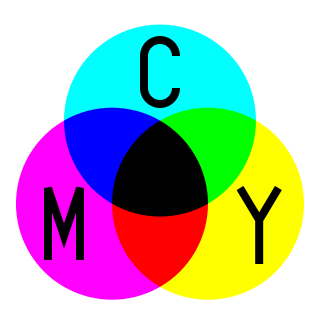 W
WSubtractive color, or "subtractive color mixing", predicts the spectral power distribution of light after it passes through successive layers of partially absorbing media. This idealized model is the essential principle of how dyes and inks are used in color printing and photography where the perception of color is elicited after white light passes through microscopic "stacks" of partially absorbing media allowing some wavelengths of light to reach the eye and not others.
 W
WThe wide-gamut RGB color space is an RGB color space developed by Adobe Systems, that offers a large gamut by using pure spectral primary colors. It is able to store a wider range of color values than sRGB or Adobe RGB color spaces. As a comparison, the wide-gamut RGB color space encompasses 77.6% of the visible colors specified by the CIELAB color space, while the standard Adobe RGB color space covers just 52.1% and sRGB covers only 35.9%.
YCbCr, Y′CbCr, or Y Pb/Cb Pr/Cr, also written as YCBCR or Y′CBCR, is a family of color spaces used as a part of the color image pipeline in video and digital photography systems. Y′ is the luma component and CB and CR are the blue-difference and red-difference chroma components. Y′ is distinguished from Y, which is luminance, meaning that light intensity is nonlinearly encoded based on gamma corrected RGB primaries.
 W
WYIQ is the color space used by the NTSC color TV system, employed mainly in North and Central America, and Japan. I stands for in-phase, while Q stands for quadrature, referring to the components used in quadrature amplitude modulation. Some forms of NTSC now use the YUV color space, which is also used by other systems such as PAL.
 W
WYPbPr or Y'PbPr, also written as YPBPR, is a color space used in video electronics, in particular in reference to component video cables. YPbPr is the analog version of the YCbCr color space; the two are numerically equivalent but YPbPr is designed for use in analog systems while YCbCr is intended for digital video.
 W
WYUV is a color encoding system typically used as part of a color image pipeline. It encodes a color image or video taking human perception into account, allowing reduced bandwidth for chrominance components, thereby typically enabling transmission errors or compression artifacts to be more efficiently masked by the human perception than using a "direct" RGB-representation. Other color encodings have similar properties, and the main reason to implement or investigate properties of Y′UV would be for interfacing with analog or digital television or photographic equipment that conforms to certain Y′UV standards.